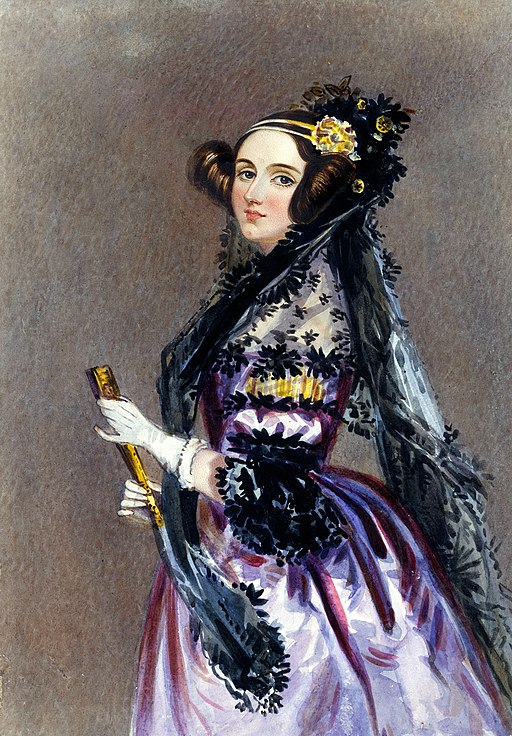The Enchantress of Numbers – A Prophetess of the Computer Age
This article commemorates the British mathematician, socialite, and translator Ada Lovelace. It was 150 years ago that this famous woman from London published the world’s first computer program capable of calculating the Bernoulli numbers. To her colleague, the mathematician Charles Babbage, she was a „enchantress of numbers“. In our time, she is considered the „prophetess of the computer age“.
Augusta Ada Byron (1815-1852)
Ada Lovelace was an English noblewoman who was born in London on the 10th of December in the year 1815. Her maiden name was Augusta Ada Byron. She was the daughter of George Gordon Byron, the 6th Baron Byron, and Anne Isabella Milbanke, the 11th Baroness Wentworth.
Ada Lovelace’s father, Lord Byron, was the most important English poet of the Romantic period. However, she had no contact with her father, as her parents separated only a month after her birth – „due to irreconcilable differences – the passionate poet, prone to fits of rage, ridiculing his mathematical, rational wife as the „Princess of Parallelograms“, and she considering her husband insane“. Ada Lovelace: Zauberin der Zahlen – Spektrum der Wissenschaft).
Ada Lovelaces Vater, Lord Byron
Lord Byron decided to formally consent to the dissolution of the marriage and relinquish his right to Ada’s education in order to avoid scandal over his lifestyle. He left England, traveled to Lake Geneva and Venice, and eventually joined the Greek freedom movement. Lord Byron died in 1824 and had no further contact with Ada. However, there is a poem he wrote for his daughter:
Lord Byron (1788–1824). Poetry of Byron. 1881.
Last leaving England
(Childe Harold, Canto iii. Stanzas 1, 2.)
IS thy face like thy mother’s, my fair child!
ADA! sole daughter of my house and heart?
When last I saw thy young blue eyes they smiled,
And then we parted,—not as now we part,
But with a hope.—
Awaking with a start,
The waters heave around me; and on high
The winds lift up their voices: I depart,
Whither I know not; but the hour’s gone by,
When Albion’s lessening shores could grieve or glad mine eye.
Once more upon the waters! yet once more!
And the waves bound beneath me as a steed
That knows his rider. Welcome to the roar!
Swift be their guidance, wheresoe’er it lead!
Though the strain’d mast should quiver as a reed,
And the rent canvass fluttering strew the gale,
Still must I on; for I am as a weed,
Flung from the rock, on Ocean’s foam, to sail
Where’er the surge may sweep, the tempest’s breath prevail.
Last leaving England – Collection at Bartleby.com
Ada Lovelace’s education
In the 19th century, it was common for the children of aristocratic families to be given private lessons at home. Ada received lessons in music and French and, at her mother’s insistence, in mathematics, geometry and astronomy. One of her teachers was Augustus De Morgan, professor of mathematics at University College London. He was highly regarded for his publications, particularly on abstract algebra and formal logic (De Morgan’s laws).
Ada had a great talent for mathematics, which was greatly encouraged by her mother, and she became acquainted with the mathematicians Mary Somerville and Charles Babbage. At the same time, Ada had social obligations and in 1835 married Lord William King, ten years her senior, from whom she inherited the title of Countess of Lovelace in 1838. Ada gave birth to three children and had little time to devote to scientific matters. However, she did not forget her mathematical studies and carried on a long scientific correspondence with Charles Babbage.
The analytical engine
Only a few years later was she able to resume her mathematical studies, working with Charles Babbage on his “ analytical engine „. This machine was designed to calculate mathematical tables.
In 1840, Charles Babbage had the opportunity to present his ideas on the analytical engine at a congress at the University of Turin. In the audience was the Italian mathematician Luigi Federico Menabrea, who wrote a summary of the lecture in French. An acquaintance of Charles Babbage asked Ada Lovelace to translate it into English. Since Ada understood the machine very well, she expanded on Menabrea’s article and added eight comments of her own.
Ada’s legacy
At Charles Babbage’s suggestion, Ada Lovelace added a concrete example explaining what kind of instructions the machine needed to calculate the so-called Bernoulli numbers. These explanations are considered the first publication of a computer program, which is why Ada Lovelace is often referred to as the world’s first programmer. In her explanations, she described the crucial difference between a calculating machine, such as a pocket calculator, and a computer: a pocket calculator performs individual arithmetic operations that a person enters manually, whereas a computer stores the instructions internally and executes them independently.
Her translation appeared in 1843 under the abbreviation „AAL“ and was enthusiastically received. Unfortunately, the calculating machine was never completed and the public lost interest in it. It was not until 100 years after Ada Lovelace’s death that her remarks about Charles Babbage’s machine became famous. The US Department of Defense even named a programming language after her: Ada.
Ada Lovelace: Zauberin der Zahlen – Spektrum der Wissenschaft
To the German translation of this article: Ada Lovelace – die erste Programmiererin
